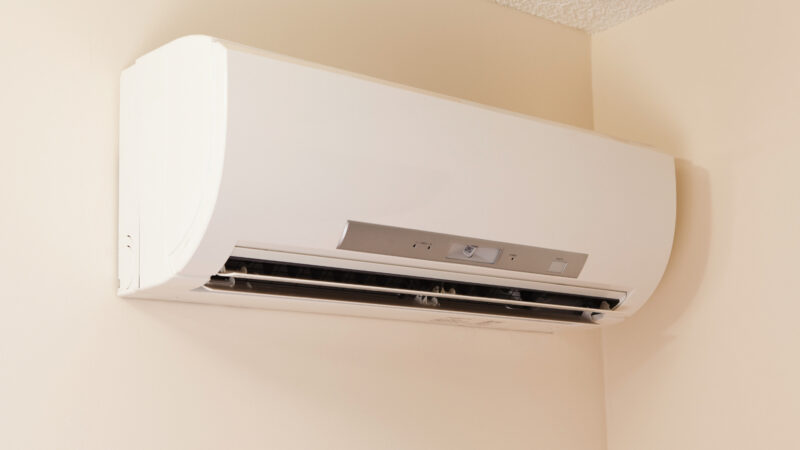Table of Contents Show
It’s sickening to watch the temperature climb in your RV if your air conditioner dies on a hot day. However, wait until you see the cost of replacing that unit. If you’re an experienced DIYer, you’ll likely consider any affordable options.
Some have discovered that mini-split units are a fraction of the cost of a standard RV air conditioner. But can you put a mini split in your camper?
If you’re tired of dripping sweat while camping, this article is for you. Let’s see if this solution can keep you cool.
What Is a Mini Split?
Mini-split units, also known as ductless air conditioning systems, have heating, ventilation, and air conditioning. They consist of two primary pieces of equipment, an outdoor and an indoor unit.
These systems don’t require ductwork to cool the space. Instead, an individual unit cools and heats that specific room. This allows you to control the climate for each room based on personal preferences and needs. If you’ve ever stayed in a hotel, you’ve likely used a mini-split air conditioner.
How Does a Mini Split Work?
A mini-split air conditioner uses outdoor and indoor components. The outdoor unit features the compressor and condenser coil, while the indoor unit has the evaporator coils. The cooling process starts with the compressor pressuring refrigerant before sending it to the condenser coil.
From there, heat releases as the pressurized refrigerant passes through the condenser. This creates a very high-pressure liquid that travels indoors through an expansion valve that lowers the pressure. This transforms the liquid into a low-pressure gas, which absorbs heat particles from the indoor air.
At this point, the air is substantially cooler than before. An indoor fan in the system pushes the air out of the unit and into the room. The refrigerant then returns to the outdoor side to restart the process. This continuous cycle can quickly cool a room down to help you maintain a comfortable space.

Will a Mini Split Work in an RV?
Wondering if a mini-split will work in your RV? Wonder no more! We recently saw a post from a fellow RVer who had his A/C unit die, and he opted to install a mini-split instead of replacing it. This shows that just about anything is possible with the right tools and knowledge.
The post garnered more than 800 likes and 230 comments. Many RVers, tired of a hot RV and noisy air conditioning units, want more options.
So with the know-how and the right unit, you can put a mini-split A/C unit in your RV.
How Much Does It Cost to Install a Mini Split?
Installing a mini-split air conditioner is much more affordable than a standard RV A/C. However, this is only if you can do the work yourself.
The RVer we mentioned said it cost him approximately $600 to install the unit. However, he had help from a friend who had the tools.
By installing it himself, he saved a ton in labor fees. Most skilled workers will charge $100 to $200 per hour for installation. This could add $1,000 to $2,000 to the total cost of the installation.
Tips to Stay Cool While RVing in the Heat
If you’re tired of sweating, we’ve got some tips to help you stay cool while RVing in the heat. Grab an ice-cold drink, and let’s dive in!
Park Strategically
When choosing a parking spot, try to take advantage of the shade. You can avoid heating the inside of your rig if you keep the sun off. If choosing between two campsites, pick the one with the most shade. Trust us, your air conditioner will appreciate it.
Additionally, consider where your windows face. Try to park so the sun isn’t beating down on the broadside of your rig. The heat from the sun can easily pass through the thin layers of glass or plastic windows and warm your RV.
Cover Your Windows
You may like the view from your massive windows, but windows are terrible for controlling the climate. The best way to keep temperatures down inside is to keep the heat outside. Depending on the size and number of windows, you’ll only need a roll or two of Reflectix to create your own climate-controlled window covering.
- Inhibits or eliminates condensation
- Nontoxic/no carcinogenic
You can easily cut this material to fit inside the frame of your windows. Combining these materials with window blinds or shades blocks a ton of heat. It may surprise you how much of an impact they can have.
Use Awnings
Another effective way to keep the sun off your RV is to use your awnings. Your awnings can block the intense heat from hitting the side of your rig, which can turn it into an oven. However, when using this method, you want to watch the weather.
You should never leave your awnings extended when you’re away from your rig. An unexpected wind gust can cause severe damage to the arms. Unfortunately, replacing a damaged awning isn’t cheap.
Keep in Mind: Are you considering an electric awning? Before you get one, see these 5 Reasons to Avoid Electric RV Awnings!

Stay Hydrated
During warm weather, you must stay hydrated. Ensure you have plenty of clean water for you and anyone else traveling with you. Many RVers use a Berkey Water Filter to help purify their drinking water.
- POTABLE WATER IN THE GREAT OUTDOORS- Black Berkey Elements remove or dramatically reduce over 200+ typical contaminants...
- ENJOY GREAT-TASTING TAP WATER EVERY DAY- The Travel Berkey System can be used at the campground, RV park, off-grid...
If you’ll be hiking during your travels, you’ll want water bottles you can easily carry. If you frequently hike, consider investing in a backpack with a water bladder. This can help ensure you always have plenty of water available when exploring nature.
Maintain Your A/C Unit
One of the best ways to stay cool in your RV is to maintain your air conditioner. Check the filters regularly and do regular maintenance. You should clean the evaporator and condenser coils a couple of times each year. However, the more you use your A/C unit, the more frequently you’ll need to clean them.
Our friends at the National RV Training Academy have an incredible video that walks you through the process. Follow the steps outlined in their video to set your A/C unit up for success.
Cook Outside
The old saying goes, “If you can’t stand the heat, stay out of the kitchen.” You know why this saying exists if you’ve ever worked in a kitchen. Cooking can create a ton of heat and increase the temperature.
We recommend getting a Blackstone Grill or using an outdoor kitchen, if you have one, to prepare meals. This allows you to keep the heat from cooking out of your RV. This eases the burden on your A/C unit and helps control the climate inside.
- Portable and Compact: This griddle is ideal for camping, tailgating, outdoor barbecues, and more. The compact design of...
- Versatile Cooking: This griddle top can handle whatever culinary creations you whip up for breakfast, lunch, or dinner....
Utilize Vent Fans
It might surprise you how much a good cross breeze can do for a space. Using vent fans can help circulate air and prevent the room from becoming stagnant. Unfortunately, many of the fans that come on RVs are practically worthless.
If you want to move some air, we suggest upgrading to a Maxxair Maxxfan. These beasts can move a lot of air compared to the standard fans. In addition, some of the premium models come with remotes and rain-detection capabilities.
Keep in Mind: Does the RV Airflow System Actually Work? Let’s take a look!
Is a Mini Split Worth It?
A mini-split can make an excellent upgrade. If you spend a lot of time camping in warmer conditions, it may be a no-brainer. Some can even heat your rig for those colder nights. So it may end up saving you money in the long term. Unfortunately, it won’t work for everyone.
If you have some DIY skills, it can be worth it. On the other hand, if you have to pay someone to install it for you, you’ll want to crunch the numbers. However, it’s hard to put a value on staying cool and comfortable while RVing.
Do you want a mini-split A/C unit in your RV?
Last update on 2024-10-21 / Affiliate links / Images from Amazon Product Advertising API










RV AC replacement cost is around $1000.
Less than 1 hr labor to swap out.
$1200 total replacement cost.
This article is so laughable.
$4K for Mini split and installation.
Signed, 20yr hvac contractor/installer.
Far from laughable as previously suggested by a supposed expert. My last roof a/c replacement (Penguine II) was $1500 plus $500 for the labor. The smaller, 10K to 15K BTU mini-splits are less than $1K with a little searching online. The most significant improvement in my opinion is the reduction in noise; and, this wasn’t even mentioned in the article. My roof a/c, which was ducted, was really noisy. When the a/c tech was swapping the units, I learned that the ducted systems loose a lot of thermal efficiency because the ducting in the ceiling is installed with very little insulation. The heat on the RV roof reduces the cooling thru the ducting. The mini-split is super quiet and directly cools the recirculated air in the RV without any losses. I’m convinced that mini-splits are better and quite surprised that RV manufacturers have been slow to incorporate into their builds.